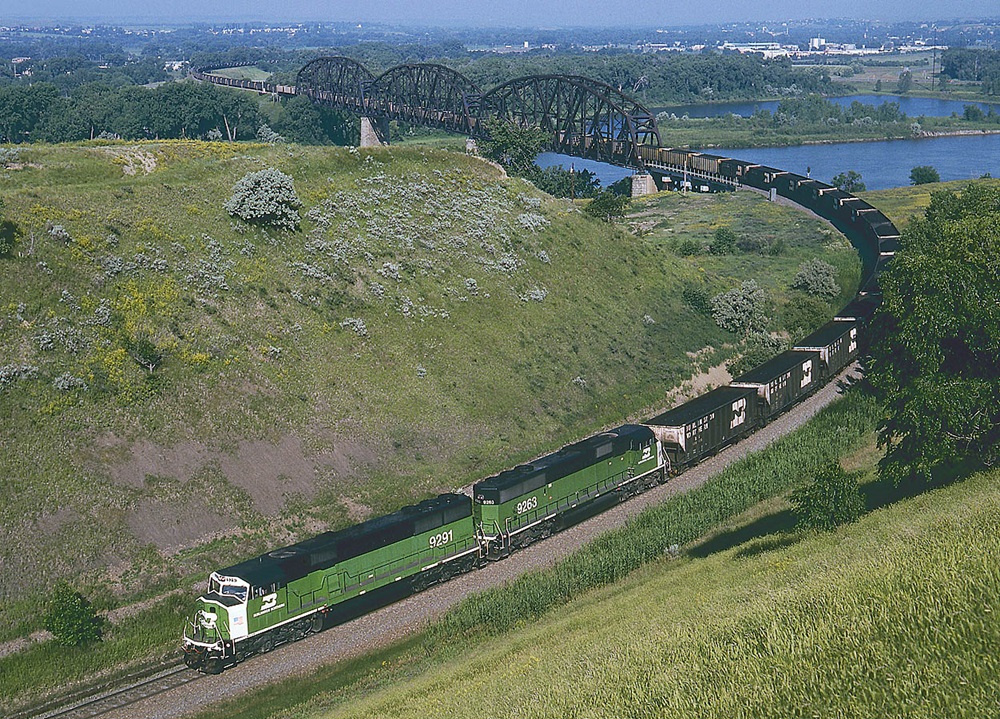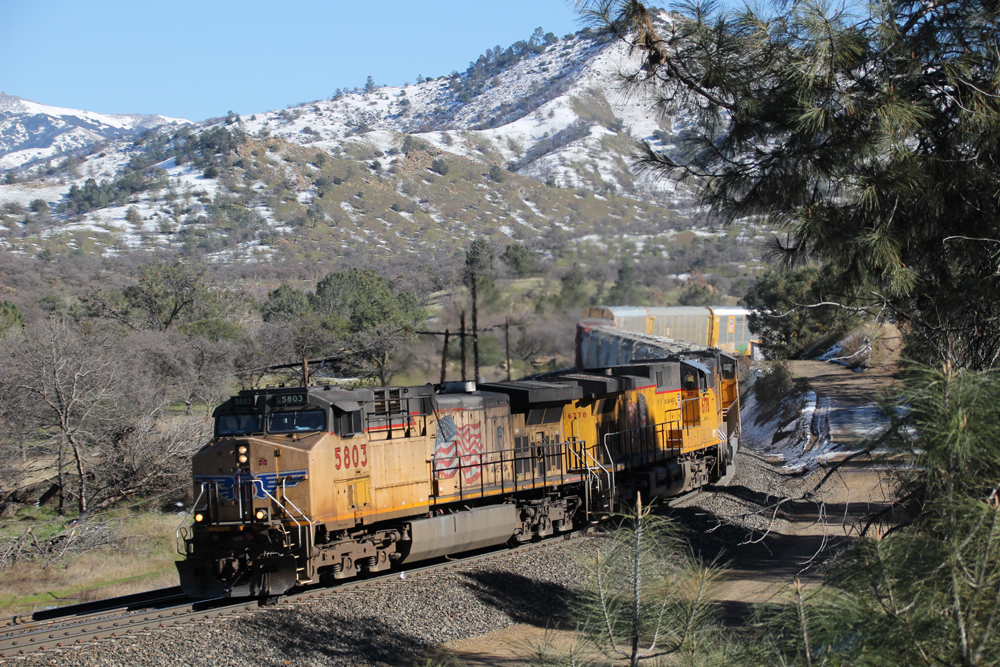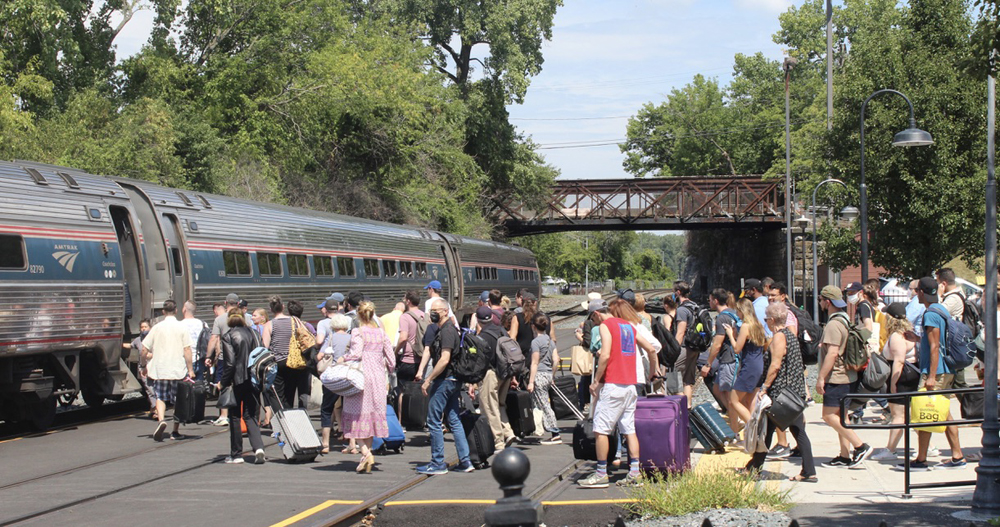
BISMARCK, N.D. — As part of its long-running effort to prevent BNSF Railway from replacing a 140-year-old bridge over the Missouri River, a preservation group argued in a Friday hearing against granting a state permit needed for the project.
The Bismarck Tribune reports the group Friends of the Rail Bridge argued in the hearing before the state Department of Water Resources that the project is a precursor to double-tracking BNSF’s line through Bismarck. A former state senator said such expansion“threatens downtown” Bismarck. The group again claimed the bridge is actually owned by the state, an argument the railroad has previously called “absurd” [see “BNSF calls preservation group’s claim …,” Trains News Wire, March 15, 2022].
The hearing was for two “sovereign lands” permits, which the railroad needs for construction within state jurisdiction, defined as lying within the ordinary high-water marks of navigable lakes and streams. One permit is needed to built the new bridge and one to remove the existing structure.
The preservation group says it does not oppose BNSF efforts to build a new bridge, but wants the current Bismarck-Mandan Rail Bridge — with piers built by Northern Pacific in 1882 — saved and turned into a walking and biking path. A 2019 study said that would cost about $7 million.
BNSF says the bridge, which has been the subject of a 25-mph slow order for several years, is nearing the end of its functional life.
The U.S. Coast Guard issued a construction permit for the new bridge in December, as did the U.S. Army Corps of Engineers. The Coast Guard’s final environmental study said there was no feasible proposal to retain the existing bridge because of the additional costs that would result, as well as the “projected floodplain rise” that could occur with side-by-side bridges in the river channel. The Friends group says that could be made moot by building the bridge further north, which the railroad and federal officials say is not feasible.
BNSF plans to build the new bridge with piers wide enough to eventually support a second track, and the preservation group says that indicates an intent to double-track the route through Bismarck, the impact of which must be considered before the bridge is approved. But BNSF attorney Laura Mona said no other work to accommodate a second track would be part of the construction, and any double tracking would require additional permits and approvals.
Also, BNSF Bridge Construction Director Mike Herzog testified that a rail bridge in Valley City, N.D. — some 135 miles east of Bismarck — was built for two tracks in 1908. “Here it is roughly 115 years later, and we still have one track across that bridge,” he said.
The preservation effort has now slowed the railroad’s efforts for at least four years, since a BNSF outlined the permitting challenges involved in the bridge project at a 2019 industry conference [see “BNSF focuses on regulatory challenges …,” News Wire, Jan. 8, 2019.] The permit requests before the state water agency are among the last permissions needed for the project.














First absurdity is the Coast Guard even being involved. Why? Many new railroad bridges are now being built to allow for future expansion. It only makes sense financially. Not only less costly if future expansion occurs, it also allows for vehicle access on and across the bridge.
A simple look up on FORB….
– Their business registration with the North Dakota Secretary of State is incomplete but is listed as in “good standing” as of 2019
– It has no officers, just an agent
– No registered tax code with the state has been filed showing they have non-profit status
– Their 501c3 number is not on their Facebook page or website (that I can find) but are soliciting donations nationally
– They are not a member of NDANO, which is optional. (North Dakota Association of Non Profit Organizations)
– North Dakota requires the following: CHARITABLE ORGANIZATION REGISTRATION STATEMENT: If the nonprofit corporation is soliciting funds, it may need to file a Charitable Organization
Registration Statement. Contact the Secretary of State’s Licensing Unit at (701) 328-3665 for information regarding a Charitable Organization Registration
Statement.
– According to the ND Secretary of State, FORB is not registered as a charitable organization
– It is unclear if they have completed the following per IRS regulations found at
https://www.irs.gov/charities-non-profits/application-for-recognition-of-exemption
They may have completed all this and it may not be visible to the public as not everything is posted online. I was just checking to see how they are setup and I can’t find any donor statements or disclosures. Not all NFP’s are required to report their financials.
John please familiarize yourself with the North Dakota Community Foundation, they are the 501c financial partner for many grassroots organizations in North Dakota, including FORB. You can make a donation to FORB here: https://ndcf.fcsuite.com/erp/donate/create/fund?funit_id=1802
Friends of the Rail Bridge is indeed registered as a domestic nonprofit corporation, with Active status and in Good Standing, with the North Dakota Secretary of State. You may use the “Search” function here to find it: https://firststop.sos.nd.gov/
Any time a group (Friends of the Bridge) does not list their board of directors and does not fill out all the paper work, I am suspicious of the group.
Ed Burns
Retired Clerk from Northtown.
The entire group stood and introduced themselves at the meeting this “news” article is describing. It’s not unlike the first public meeting from over 5 years ago when the project began. It appears that local residents remain very passionate about the project, just as they were back then: https://www.youtube.com/watch?v=5GJe_El9xYo
I did locate some records for FORB under NDCF.
NDCF is essentially a tax free conduit supporting all of the scholarships, endowments, NFP’s and grants for all of the 501c3’s and other organizations who register themselves appropriately. It’s a very worthy organization from my research as they help manage and channel money between donors/grants to recipients who request it.
FORB is listed as a “Other Non-Endowment Fund”. Meaning money donated through NDCF passes through to them.
In the NDCF annual reports:
In 2021, FORB raised $19,742.00
In 2020, FORB raised $4,886.00
In 2019, FORB raised $15,308.00
In 2018, FORB raised $13,260.00 (reported as first year with NDCF)
NDCF has not posted their 2022 year end report yet.
Do what the Union Pacific did on the Bridge in Boone Iowa Just build a New Bridge beside it and Let the State Preservation Buy it End of Story
I was Roadmaster’s Clerk for the BN from 1985 to 1990. My comment is that the BNSF should deed the bridge to the Friends of the Bridge, then it will be their responsbility. BUT, the CNW abandoned a line to the Michigan Department of Natural Resources for a recreational/snowmobile trail. Many years later, a person got hurt on the trail and sued the CNW.
Any comments?
Ed Burns
Retired Clerk from Northtown.
North Dakotans love being outdoors and is a gem for all sorts of recreation. Recreational Immunity laws in North Dakota are quite strong in removing liability for a landowner if someone hurts themselves on private property. Here is a case where Recreational Immunity was upheld and a lady was not awarded damages after hurting her leg at the fairgrounds: https://www.swlattorneys.com/recreational-immunity-north-dakota/
Here is a case where 2 people hurt themselves sledding in Bismarck and were not allowed to pursue damages against the landowner because of Recreational Immunity laws:
https://www.casemine.com/judgement/us/59147b6eadd7b0493441d02c
Here is a link to the North Dakota Century Code spelling out that the landowner is not responsible if a person hurts themselves while doing free recreation EVEN IF there is a known hazard on the property:
https://www.ndlegis.gov/cencode/t53c08.pdf
Who is funding these people?
As far as how long this takes, yes, it takes a long time to slow down a train once it’s got running good.
Just because a railroad representative says it in a meeting, does not make it so. Readers (and the author of this article) can find clear information regarding who owns the Missouri River, and the black-and-white language in the North Dakota State Constitution regarding ownership of the historic bridge, with actual citations, at the following link: https://www.friendsoftherailbridge.org/s/Final-Memorandum-to-USCG-April-4-2022-Revised-4-5-22.pdf
Several points in this article are just wrong. “The railroad” themselves asserted that a bridge construction project a bit north, preserving the historic bridge, is feasible. At this point, it’s a real question whether that alternative would actually cost any more dollars compared to the proposal. Or, if you could go back 6 years to the beginning of the project, if it wouldn’t have been cheaper at that point, before threatening to tear down the single most important and sturdiest structure ever built in Dakota Territory. From that perspective, the new bridge would probably be up-and-running a couple years by now.
In the public meeting on 1/20/2023, railroad officials referred to the river crossing as their own “real estate”. This would directly clash with North Dakota Attorney General Drew Wrigley’s assessment of who owns the “real estate” of the Missouri River, here: https://kfgo.com/2022/04/30/state-moves-to-intervene-in-tribes-lawsuit-over-claim-to-minerals-under-missouri-river/
Would a group of dedicated citizens really have the ability to slow down the USCG, COE, Berkshire-Hathaway . . . if there were no meat on the bone?
Regarding the likelihood of double-tracking, the railroad has mailed local residents flyers stating the growing need to increase efficiency is a driving force in building a bridge to support double tracks. “To meet future rail capacity needs, BNSF plans to build a bridge that could support a second main track when needed.” Regardless of when this will occur, NOW is the only time to consider the effects that would have. Ignoring it constitutes neglect of Bismarck and Mandan’s future interests.
I don’t expect unbiased reporting from Trains.com, don’t know if I should. But anyone looking at this situation objectively ought to be asking: Wait, is there more to this? Is there actually black-and-white constitutional verbiage stating who owns what in this instance? Could the railroad actually have owned the Missouri River this whole time? Should the railroad have been paying rent to the landowner for the privilege of the easement?
It would mean nothing to BNSF’s bottom line to preserve the historic bridge. I’m constantly struck by how many railroaders bemoan the treatment they get from companies that refuse to even allow sick days, which are constantly trying to cut their jobs for PSR, who have a confusing system of even figuring out if your ability to retire is on track . . . and then come bang on their keyboards to defend Warren Buffett’s “crown jewel” of consistent profits.
My response to your comments about future double tracking of the line through Bismarck: interstate commerce over a carrier that existed before the town overrules any potential issues with double track in the future. Of course double tracking can be mitigated with grade separations and sound walls. The health of the economy outweighs anything here…if you don’t like the sound of trains, there’s planty of people that do who would be willing to buy your property.
I don’t think anyone here is defending BNSF, Berkshire or their profits. I think they are challenging the notion that an organization appears to be trying to get something for nothing using an arcane argument in constitutional law that has no precedent (anywhere).
Nationally, the precedence (or practice) has been if somebody wants someone’s asset, they either pay them in fee simple or have it donated in-kind. But it appears FORB wants to foreclose on the asset and take it with no compensation to its current owner, because as you try to argue, they aren’t the owner.
Public bodies can condemn assets if they are considered in the public good and there is precedence for railroad bridges being condemned through legal means. (ie: McKinley Bridge – St Louis)
BNSF is not donating the asset that they have clear title too and FORB is not offering to pay for it. (Neither is the State of ND)
If the AG of North Dakota has no desire to file a condemnation suit against BNSF for the bridge, then the pushback goes towards FORB alone.
It’s FORB’s argument to make and they have every right to do so in every court in the nation. No one in this forum is saying you shouldnt have access to jurisprudence, they just don’t agree with the premise of the argument.
It will be interesting to see if FORB takes this up in the Federal Circuit. One of the issues (IMHO) will be standing.
If this preservation group wants to keep the existing bridge, they should simply buy it from BNSF and guarantee that THEY will maintain and “improve” it at their own expense. Why should anyone else have to supply funds?
“And the seasons they go round and round, And the painted ponies go up and down, We’re captive on a carousel of time”….song lyrics from Joni Mitchell “The Circle Game”…
How many decades does it take for our government to make a simple decision?
Just decades?